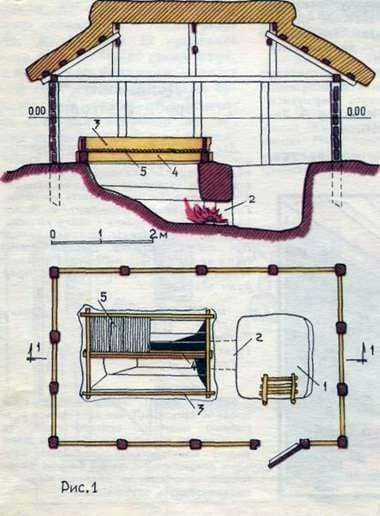
Fig. 1. Traditional drying. Section, plan: 1 – pit; 2 – the furnace; 3 – frame; 4-lead; 5 – grating of hazel rods.
Since ancient times in Ukraine, the basis of food production was the peasant household. The family form of work allowed to supply meat, milk, bread, vegetables, fruits and other products for sale. Depending on the climatic conditions, the activities of the peasant, in the complex of the estate, various buildings were constructed, which appropriately managed and processed the processed products.
Unfortunately, many traditional forms of economic management have already been lost. Many types of traditional buildings of the peasant household have disappeared and disappeared, the centuries-old experience of family management has been lost. Deciding today the issue of increasing the production of agricultural products, we should not forget about the traditions of the past, but cleverly use the progressive assets of the people.
In recent years, not only the peasants, but also the inhabitants of cities are captured by gardening. The grown crop can not always be kept fresh for a long time, because it needs urgent processing. Among the known methods of harvesting fruits, one of the oldest is drying.
Nutritious and delicious dried fruits occupy an important place in the folk food. Prunes are especially in demand, the technology of which is known in Ukraine for a long time. And so it is not accidental in the beginning of the XX century. this delicacy was even exported abroad. Dried fruits are widely used in modern Ukrainian cuisine. However, to meet the needs of the population in dried fruits, it is necessary to revive the well-known in the past in Ukraine folk craft processing of pears, plums, apples by drying.
Fig. 2. Brick drying. General form.

As you know, dried fruit not only in the sun or in the oven, but in the facilities created for this – drying. By the way, such buildings took place not only in Ukraine. They are known in Moldova and the Caucasus. Until now, drying can still be found in the villages of Vinnitsa, Khmelnitsky, Poltava, Chernivtsi regions.
Traditional drying is a pit-furnace with a trough-channel duct, above which a small cage made of twigs or plates in two or three wreaths was made. In the longitudinal direction, the lower of the crowns was fastened with the mattress, creating the basis for the arrangement of the grid from the densely laid hazelnut rods. Fruit was placed on the grate about 15 cm thick. During the burning of wood in the oven, heat and smoke pass through the layers of fruit, thereby drying them. To protect the drying from the atmospheric precipitation, a roof with a straw coating was arranged above it; Sometimes they made a small land building, as a rule, with walls of a frame structure, i. e. from planks in the cast or wicker from hazelnut or willow twigs.
Later, to improve the thermal properties of the furnace and the channel began to enclose a natural stone or brick or build completely drying on the surface of the earth. For reasons of fire safety, it was placed in a peasant’s yard at some distance from housing and other economic buildings.
It is fully understood that in modern conditions, borrowing only the principle of drying, traditional construction can be significantly improved both in technological and in a constructive and aesthetic solution. Designed to meet the needs of a particular farm, without significant material costs, some modified drying will enable to save and process a significant part of the grown crop, and will help enrich the counters of shops and collective farms with a variety of delicious fruits.
Перевозка ульев с пчелами. Трутневая семья.
Useful tips for the amateur beekeeper